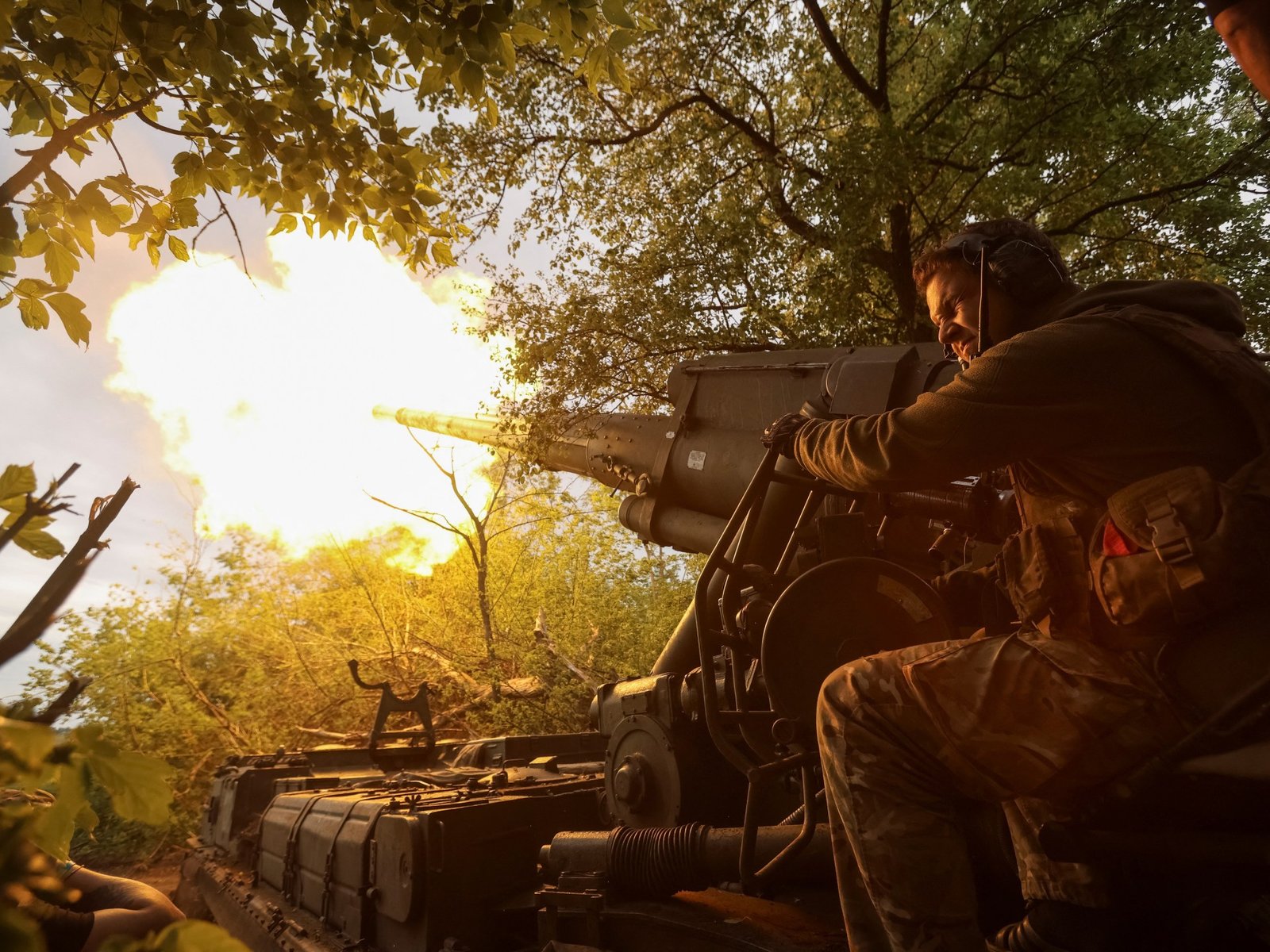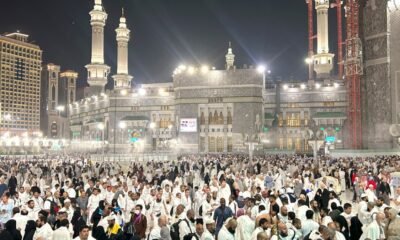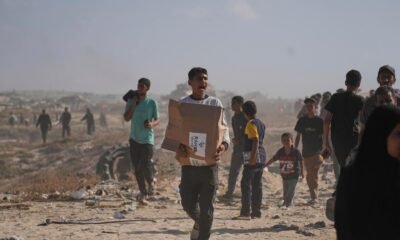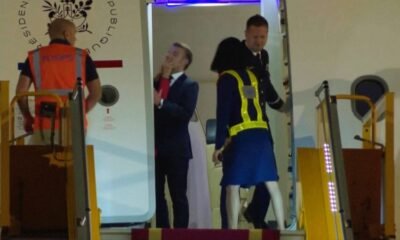Conflict Zones
Gaza’s stolen childhood: The thousands of children Israel killed | Israel-Palestine conflict News
Israel kills a child in Gaza every 45 minutes.
That is an average of 30 children killed every day over the past 535 days.
Since October 7, 2023, Israel has killed at least 17,400 children, including 15,600 who have been identified. Many more remain buried under the rubble, most presumed dead.
Many of the surviving children have endured the trauma of multiple wars, and all of them have spent their lives under the oppressive shadow of an Israeli blockade, affecting every aspect of their existence from birth.
What is left of Gaza’s children?
About half of Gaza’s 2.3 million residents are children.
Over the past 17 months, Israeli attacks have left their homes in ruins, destroyed their schools, and overwhelmed their healthcare facilities.
To put this in perspective, if you had a room of 100 children:
2 have been killed
2 are missing, presumed dead
3 have been wounded, many critically
5 have been orphaned or separated from their parents
5 require treatment for acute malnutrition
The rest of the children bear the invisible scars of war, trauma that affects their mental health, safety and future.

Who were these children Israel killed?
They were the sons and daughters of Gaza, each with a life that should have been filled with innocence and the joy of childhood.
Among the documented children killed, there were –
at least 825 babies, not yet old enough to celebrate their first birthday
895 one-year-olds, killed before they could take their first steps
3,266 who died as preschoolers aged two to five, deprived of play, discovery and the simple wonders of growing up
4,032 who died aged six to 10, leaving behind empty classrooms and school uniforms that were hardly worn
3,646 who died aged 11 to 14, middle schoolers who had lived through three wars (2012, 2014, 2021), but were killed in the fourth
and 2,949 who were 15 to 17, at the age when they were preparing to step into the world, leaving behind dreams of independence and futures never realised; the 17-year-olds lived through four wars (2008-09, 2012, 2014, 2021), and were killed in the fifth
8,899 who were sons and 6,714 were daughters

1,720 killed before their first steps


On March 18, Israeli forces launched 100 simultaneous strikes across the Gaza Strip, shattering a two-month-old ceasefire with Hamas.
Over the next 36 hours, 436 people were killed, including at least 183 children, 94 women, 34 elderly people, and 125 men.
Among the children killed was one-year-old Mohammed Abu Hilal, who died along with his seven-month-pregnant mother, Afnan, in an Israeli air attack on the al-Mawasi camp – a location Israel had claimed was a “safe zone”. His father Alaa had sent them there in the hope of keeping them safe.
“Oh, my dear son, go up to heaven, you’re going to find all your toys up there,” the heartbroken father cried as he held his son’s lifeless body.
Mohammed was among 895 one-year-olds – and 935 children named Mohammed – killed by Israeli attacks.
3,266 deprived of the joys of play


Reem was just three years old when she was killed, alongside her five-year-old brother Tarek, in an Israeli air attack on their family home in the Nuseirat refugee camp in November 2023.
Following her death, a video of her grandfather, Khaled Nabhan, cradling her lifeless body and calling her “Soul of my soul” spread widely, symbolising the immense suffering endured by Gaza’s population.
Khaled cherished his beloved granddaughter and recalled sadly how she would greet him with a hug every day.
On December 16, 2024, Khaled, who dedicated his time to helping those in need, was also killed by an Israeli strike.
4,032 leaving empty classrooms


Hind Rajab, five, was a bright, kind-hearted child full of life and curiosity, her family and neighbours said.
On January 29, 2024, Hind found herself the only survivor in a blood-soaked car filled with the bodies of her family.
They had been targeted by an Israeli tank as they tried to flee Israeli bombardment on Tal al-Hawa neighbourhood. Hind was left alone but managed to call the Palestine Red Crescent Society (PRCS).
In her final moments, she pleaded for help over the phone, her terrified cries echoing across the world.
“I’m so scared, please come. Please send someone to take me,” she repeated during a harrowing three-hour conversation with emergency services that Israel was blocking from reaching her.
Her body was discovered 12 days later alongside those of her family and the medics who had attempted to save her.
The Hind Rajab Foundation continues to honour her memory and seek justice for her and others affected by Israel’s war on Gaza.
3,646 killed before they could grow up


On October 19, 2023, an Israeli air strike struck Gaza’s oldest church, Saint Porphyrius, killing at least 18 people.
Among those killed were siblings, Suhail Ramez al-Souri (14), Julie Ramez al-Souri (12) and Majd Ramez al-Souri (10).
Their heartbroken father recounted the devastating moment his children were killed while seeking refuge inside the church.
“We thought this was our safe haven,” he said through tears, “Our last refuge, in the house of God.”
“They bombed my angels without warning. They killed our children, the children of cousins, relatives,” the grieving father added.
2,949 futures never realised


Mahmoud wanted to be a journalist, just like his father.
Determined to share the stories of his homeland with the world, the 15-year-old, known as “young Wael”, together with his sister Khuloud, started recording videos documenting the effects of Israel’s escalating violence on Gaza.
“In Gaza, there is no place safe … this is the [fiercest] and most violent war we have lived [through] in Gaza. Help us to stay alive,” the young Dahdouh duo pleaded.
On the night of October 25, 2023, Mahmoud was killed, along with his mother, seven-year-old sister Sham, one-and-a-half-year-old nephew Adam and 21 others, in an Israeli air raid on the Nuseirat camp where the family had sought shelter after being told by the Israeli army to move south for their safety.
The stories of children like Mohammed, Reem, Hind, the al-Souri siblings, and Mahmoud reflect the countless childhoods stolen in Gaza, leaving behind memories of innocence and futures that will never be realised.
Conflict Zones
Ballet helps fight war fatigue in Ukraine’s front-line Kharkiv city | Russia-Ukraine war

In the Ukrainian city of Kharkiv, escaping the war with Russia is nearly impossible.
On certain days, when the wind shifts, residents of this historic city can hear the distant rumble of artillery fire from the front line, some 30km (18.5 miles) away.
Most nights, Russian kamikaze drones packed with explosives buzz overhead as parents put their children to bed.
Three years since Russia’s invasion of Ukraine, the unrelenting war exerts a heavy psychological burden on many in Kharkiv. Yet, there is a place in the city where, for a few fleeting hours, the war seems to vanish.
Beneath the Kharkiv National Academic Opera and Ballet Theatre, in a dim, brick-walled basement, a dance company has established a refuge from drones and bombs – a space where audiences can lose themselves in performances of classic ballets.
In April, this underground venue hosted performances of Chopiniana, an early 20th-century ballet set to the music of Frederic Chopin. Despite the improvised setting, the ballet was staged with full classical grandeur, complete with corps de ballet and orchestra.

It marked a significant milestone for Kharkiv’s cultural life: the first complete classical ballet performance in the city since February 2022, when Russian troops launched their invasion of Ukraine.
“In spite of everything – the fact that bombs are flying, drones, and everything else – we can give a gift of something wonderful to people,” said Antonina Radiievska, artistic director of Opera East, the ballet company behind the production.
“They can come and, even if it’s just for an hour or two, completely immerse themselves in a different world.”
Despite Ukraine’s rich tradition in classical ballet, the art form now seems far removed from the everyday existence of Ukrainians living through war. Daily routines revolve around monitoring apps for drone alerts, sleeping on metro station floors to escape air raids, or seeking news of loved ones on the front line. Pirouettes, pas de deux and chiffon tutus feel worlds away.
Nevertheless, the journey of Kharkiv’s ballet through wartime reflects the ways in which Ukrainian society has adapted and evolved.
On February 23, 2022, the National Academic Opera and Ballet Theatre staged a performance of the ballet Giselle. The next day, Russia launched its full-scale invasion. As Moscow’s forces advanced towards Kharkiv and threatened to seize the city, the theatre closed its doors and much of the ballet troupe departed.
Some regrouped in Slovakia and Lithuania, mounting ballet productions abroad with assistance from European sponsors.

By 2023, although the conflict ground on, the situation in Kharkiv, in Ukraine’s northeast, had stabilised after Russian ground troops withdrew. A new realisation took hold – this was a long-term reality. Locals began referring to the city, and themselves, with the Ukrainian word “nezlamniy”, meaning invincible.
That year, work began on transforming the theatre’s basement into a performance venue. By October 2023, it was being used for rehearsals. The following spring, authorities permitted the theatre to admit audiences, and small-scale ballet performances, including children’s concerts, resumed.
The revival of Chopiniana marked the next chapter in Kharkiv’s wartime cultural journey.
Staging a classical opera again signals that Ukraine endures, says Igor Tuluzov, director-general of Opera East. “We are demonstrating to the world that we really are a self-sufficient state, independent, in all its aspects, including cultural independence,” he said.
The auditorium now seats 400 people on stackable chairs, compared with the 1,750 seats in the main theatre above, where the plush mustard seats remain empty.
The stage is a quarter the size of the main one. Grey-painted bricks, concrete floors, and exposed pipes and wiring form a stark contrast to the varnished hardwood and marble of the theatre above. The basement’s acoustics, performers say, fall short of the cavernous main auditorium.
For artistic director Radiievska, however, the most important thing is that, after a long pause, she and her troupe can once again perform for a live audience.
“It means, you know, life,” she said. “An artist cannot exist without the stage, without creativity, without dance or song. It’s like a rebirth.”
Conflict Zones
Sudan Paramilitary Claims Key Gains in Kordofan; Fighting Intensifies Near Khartoum

Khartoum, May 30, 2025 — Rapid Support Forces (RSF) deputy leader Abdel Rahim Daglo announced on Friday that RSF fighters would press their eastward advance toward Khartoum, claiming “great victories” in several strategic towns across Kordofan. Addressing troops at an undisclosed location, Daglo said that all armed groups within the Tasis coalition had joined his paramilitary ranks and were now operating in concert with the RSF.
According to Daglo, RSF units seized control of Al-Dubaibat and Al-Hammadi in South Kordofan state, as well as Al-Khawi in neighboring West Kordofan. “Our fighters have secured these areas after intense clashes with Sudanese Armed Forces (SAF) units and allied militias,” Daglo declared, adding that the momentum would not wane until the capital was within reach.
Sudan’s army, however, downplayed recent RSF advances as part of a “reorganization” campaign. A senior ally of the SAF—also the governor of Darfur—insisted that the military was regrouping and fortified its positions to counter what he described as “a temporary setback.” He maintained that the SAF’s strategic reserves remained intact and that front-line forces were being repositioned to mount a sustained defense of Khartoum.
As fighting has spread northward, the humanitarian situation in Khartoum has deteriorated sharply. With basic services all but collapsed, a deadly cholera outbreak has emerged in the densely populated capital. Aid agencies warn that the impending rainy season could exacerbate sanitation challenges, fueling further disease transmission. The United Nations has labeled the crisis “the world’s worst humanitarian emergency,” citing over 25,000 confirmed deaths and more than 3 million internally displaced persons since April.
International pressure has also mounted on Sudan’s transitional government. In late May, Washington imposed sanctions on Sudanese military leaders for the “alleged use of chemical weapons” against civilians. In response, the government announced a national investigation into the claims—a move it said was aimed at preserving Sudan’s international standing amid intensifying conflict.
With both sides entrenching their positions around Khartoum, observers warn that a protracted stalemate could unleash further civilian suffering. The RSF’s pledge to advance eastward has raised concerns that front-line engagements may spill into densely populated suburbs, where millions have already endured weeks of intermittent shelling and aerial bombardments. For now, the fate of Khartoum—and the broader prospects for peace—remain uncertain as paramilitary and army forces brace for a decisive showdown.
Conflict Zones
Two killed in Russian attacks on Ukraine before possible talks in Turkiye | Russia-Ukraine war News

Russia has confirmed it will send a delegation to Istanbul, but Kyiv has not yet accepted the proposal.
Russian drone and missile attacks on Ukraine have killed at least two people, according to officials, as Ukraine ordered the evacuation of 11 more villages in its Sumy region bordering Russia.
Russian troops launched an estimated 109 drones and five missiles across Ukraine on Friday and overnight, the Ukrainian air force said on Saturday, adding that three of the missiles and 42 drones were destroyed and another 30 drones failed to reach their targets without causing damage.
The attacks came amid uncertainty over whether Kyiv will take part in a new round of peace talks early next week in Istanbul.
In the Russian attacks on Saturday, a child was killed in a strike on the front-line village of Dolynka in the Zaporizhia region, and another was injured, Zaporizhia’s Governor Ivan Fedorov said.
“One house was destroyed. The shockwave from the blast also damaged several other houses, cars, and outbuildings,” Fedorov wrote on Telegram.
A man was also killed by Russian shelling in Ukraine’s Kherson region, Governor Oleksandr Prokudin wrote on Telegram.
Moscow did not comment on either attack.
Meanwhile, authorities in Ukraine’s Sumy region said they were evacuating 11 villages within a roughly 30-kilometre (19-mile) range from the Russian border.
“The decision was made in view of the constant threat to civilian life as a result of shelling of border communities,” the regional administration said on social media.
Ukrainian President Volodymyr Zelenskyy has said some 50,000 Russian troops have amassed in the area with the intention of launching an offensive to carve out a buffer zone inside Ukrainian territory.
Ukraine’s top army chief, Oleksandr Syrskii, said on Saturday that Russian forces were focusing their main offensive efforts on Pokrovsk, Torets and Lyman in the Donetsk region, as well as the Sumy border area.
Syrskii added that Ukrainian forces are still holding territory in Russia’s Kursk region – a statement Moscow has repeatedly denied.
The evacuations and attacks came just two days before a possible meeting between Kyiv and Moscow in Istanbul, as Washington called on both countries to end the three-year war.
Russia has confirmed it will send a delegation, but Kyiv has not yet accepted the proposal, warning the talks would not yield results unless the Kremlin provided its peace terms in advance.
Zelenskyy said Saturday it was still not clear what Moscow was planning to achieve at the meeting and that so far, it did not “look very serious”.
-

 Africa4 days ago
Africa4 days agoSurvivor of Liverpool car ramming talks of shock and panic
-

 Sports3 days ago
Sports3 days agoThe Knicks are bringing hope and title dreams back to New York after years in the doldrums
-

 Lifestyle3 days ago
Lifestyle3 days agoChildren and careers: Talking to kids about what they want to be when they grow up
-

 Lifestyle4 days ago
Lifestyle4 days agoHow to decorate a patio, balcony or other small outdoor space
-

 Lifestyle4 days ago
Lifestyle4 days agoFaizan Zaki hopes to go from spelling bee runner-up to champ
-

 Middle East5 days ago
Middle East5 days agoHajj pilgrimage in Saudi Arabia to begin on June 4 | Religion News
-

 Middle East4 days ago
Middle East4 days agoGaza’s aid system isn’t broken. It’s working exactly as designed | Humanitarian Crises
-

 Europe5 days ago
Europe5 days agoMacron’s marital shove disappears from French airwaves




